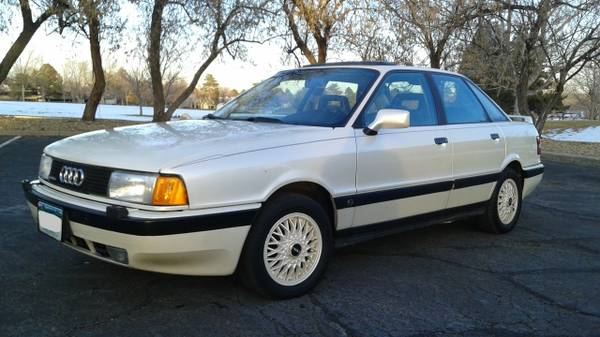Every year for the past decade I’ve headed towards the colder climates to enjoy some time exploring the limits of winter driving in schools put on by the Audi Club. Held on frozen lakes or in specific dedicated facilities, these schools allow you to do what’s simply not safe or legal on the regular roads; to get the car out of shape and beyond the limit of grip and learn to get back under control. Predictably every year there’s a crop of the newest and greatest from Audi, Subaru and even BMW. But around the ice, the best performers are still the old ladies; Audi 4000, 80 and 90 quattros comprise a small minority but generally blow right by all the “faster” cars once the grip declines. But while examples of the early quattros are never particularly expensive compared to new cars, finding the right one to buy and turn into a “winter beater” is a bit harder since they’re few and far between. So when this complete and solid but slightly weathered 1990 80 quattro turned up, my thoughts immediately turned towards the ice:
Tag: B3
For me, it’s been a week of some unappreciated cars, and the Audi Coupe Quattro ranks up there as one of the most unappreciated Audis. But unlike the wild turbocharged wonders that were available in the rest of the world, the U.S. market received only the 7A inline-5 20 valve motor. Basically, it was a 16V Volkswagen motor with one more cylinder; with a 7,200 rpm redline, the sonorous 5-pot put out a respectable 164 horsepower. That wasn’t much less than the E30 M3 had and matched U.S. bound turbocharged Quattros – but the power delivery was such that the car didn’t feel fast off the line, and the weight didn’t help. The B3 was hefty, saddled with improved safety options like PROCON-10, anti-lock brakes and a stronger platform, it was also decidedly more luxury oriented with electric seats, sunroof, windows, air conditioning and even an electronic lock for the differential in the rear. It was the 1980s Audis all grown up, but the impression left in many enthusiast’s mouths was that it was a bit soft and a bit slow. Ironically, the 7A even gained a bad reputation amongst enthusiasts as an underpowered unit that lacked torque – but a look at the original power numbers prove it was the most powerful of the non-turbo, non-V8 cars Audi offered at the time. 1992 would see a switch to the B4 platform with the V6 power unit and the end of B3 production; slow sales and a high price meant the Coupe Quattro was removed from the U.S. bound lineup after only a reported 1,500 made it here. Despite their perceived lack of sport, the legendarily stout Coupe Quattros served many of their owners well and many are still kicking around. Only one, though, is in the condition of today’s example:
CLICK FOR DETAILS: 1991 Audi Coupe Quattro at Sutherland Auto Sales
12 CommentsIn the realm of German cars, Audi seems to be the unappreciated marque when you go back a few generations. But even then, amongst the leper colony of Audi products that no one wants, the Audi 80 quattro is close to King. I say close to King, because truth be told I think there are even less appreciated products from this time – the front drive Audi 100, for example. But go to 1991, and within Audi all enthusiasts are generally interested in is the 200 20V quattro, the Coupe quattro, and occasionally someone will mention the V8 quattro 5-speed. The 80 quattro, though, was one of the smartest options if you wanted a robust, small all-wheel drive sedan. True, the switch from B2 to B3 gained a fair amount of weight and not much more power from the NG 2.3 liter inline-5. It felt, if anything, a bit slower off the line than the 4000 quattro had been – a car not noted for it’s straight line dominance. But its unpopularity ironically made it quite popular as a tuning platform; after all, it does share some DNA with the much loved RS2. In this case, the builder of this car has thoroughly upgraded this B3 to new levels of power and performance:
CLICK FOR DETAILS: 1991 Audi 80 quattro on Classic-Audi.co.uk
1 CommentWhen BMW upped its game in the E36 chassis with the introduction of the M3, specialty tuner Alpina answered with the B3 3.0 and later 3.2 in step with BMW. The successor of the slightly less powerful B6 model, the B3 kept many of the same improvements to the E36 chassis – unique stabilizers, springs and shocks, and larger brakes. Inside the B3 received the normal Alpina-style shift knob, steering wheel and seats, and in their typical style Alpina provided unique front and rear spoilers along with their own badging. Of course, the package was rounded out by some of the best looking wheels ever fitted to a BMW. While the B3 was down on power to the European M3 3.2, it wasn’t really much slower – again in typical Alpina fashion, the car was tuned to make the most of the power that was available rather than just provide a shockingly high output number. A reported 1,000 of these ultra-exclusive B3s were produced, with about 2/3rds of those being the earlier 3.0 model. With only 342 of the 3.2 produced, the pool is already very exclusive on these. Add a manual transmission when most are automatic, special order Dakar Yellow paint and a cabriolet model, and this is among the most exclusive Alpinas ever made.





